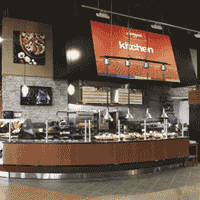Today’s foodservice operators have to do everything from enforcing sound sustainability practices to evolving with technology to meet customer demands
Every new year dawns with fresh hope and wild ideas that promise to transform the foodservice landscape. The dawning of this next decade doesn’t disappoint, with no shortage of innovation predicted and emerging across all sectors. In no particular order, here are 10 key trends shaping the industry today.
OPERATIONAL SWITCH-UP
The sky’s the limit in the foodservice industry, which explains why humble food truck operators—their on-the-road ambiguities once the source of anxious avoidance by most consumers — are enjoying wild popularity. They’re facilitated by social media that alerts foodies of their whereabouts and lauded for their nouveau-chic status and preparation of highly specialized, gourmet fare (generally by hip young chefs), such as heirloom tomato/watermelon salads and tempura cod tacos of Toronto-based El Gastrónomo Vagabundo.
Initially an L.A. and New York fad alone, their colourful travels have extended, with stationary restaurants taking to the road in a bid to expand brands (and regulatory agencies scrambling to keep pace) and exploit a unique opportunity to marry boundless creativity with wheels. Take Ryan Smolkin, of the Toronto-based Smoke’s Poutinerie, who is taking full advantage of the trend, carting his branded truck around the city and even fielding franchising requests for the marketing behemoth on wheels. And, innovation blooms elsewhere across the newly no-holds-barred scene, with pop-up restaurants—such as theMontreal-basedMuvbox, which transforms from a crate to a restaurant on command, or the temporary resto One Hundred Days at Opus Hotel Vancouver, which served as a prelude to the property’s restaurant re-launch. There are also kiosks littering the scene, street food coming resoundingly into its own and kitchen-swapping gaining heretofore uncharted popularity. Visiting chefs are even opting for different digs, similar to what will take place at Ottawa’s National Arts Centre this month when eight top toques, from Nova Scotia to British Columbia, are paired with their counterparts from the hosting city for the country’s first annual Canadian Celebrity Chefs Event.
ACTION IN ADULT BEVERAGES
As the continent surfaces tentatively from a slamming recession, inventive interpretations of liquid refreshment are sweeping in to encourage a celebratory spirit in foodservice establishments. Retro cocktails (think whisky sours and sloe-gin fizzes) take top billing, thanks in no small part to the ultra-cool Don Draper and his old fashioned swilling gang on the television dramaMadMen.More than that, there’s a resurgence of gin, bourbon, craft beers, punch (especially sangria) and herb-infused thirst quenchers in the fast-casual segment, according to reports from Chicago-based foodservice research and consulting firm Technomic Inc. So-called “skinny” beverages, such as cocktails that feature fresh, natural ingredients and lively spirits, rather than sugary artifice (skinny margarita, anyone?)
are also on the move. Starbucks straddled the trend early with its experimental 100-calorie skinny peppermint mocha, south of the border. Even SkinnyWater (oxymoron notwithstanding) is attracting attention, recently recognized by Women’s Health magazine as one of the 125 “best packaged foods for women.”
DEMOGRAPHICS-POWERED TRENDS
There’s no question demographics influence restaurant fortunes. It’s why you can find South Asian burfi,Manchurian fried rice and gulab jamun on a workaday menu today. And, it’s why the industry can’t ignore a customer base whose increasing age means it’s patronizing restaurants less and shifting spending away from quick-servicerestaurants (QSR) over to full-service streams. And, so, say the pundits, while QSR will remain the largest channel, it will also bare the
biggest impact of slowing growth. In turn, says Linda Strachan, an industry analyst with the Toronto-based NPD Group, QSR players should review their operations to increase appeal for the older consumer,similar to what McDonald’s has done with the addition of fireplaces, cushy chairs and frequent offers of free coffee. As for the less-populous (but more spendthrift) Gen-Ys—foodservice’s heaviest users — expect them to carry their habits forward, ensuring
enduring patronage for responsive QSRs.
HIGH-LOW PRICING
While most consumers will continue to demand low prices and most restaurateurs will continue to accommodate them, on the horizonthere’s a counter trend to luxury dining at the high-end and to affordable high-experience-value dining in the mass market as is evidenced at Red Lobster and Wendy’s. This so-called “ladder-pricing strategy” must, in the wake of the recession, identify different pricepoints at the low, mid and high rungs, each of which takes discreet
aim at different types of consumers and not only what they’re able to, but what they’re willing to spend. Look atMcDonald’s dollar items at the low-end, signature items in the middle and premium items at the top. Alternately, at a Ruth’s Chris Steak House, a person who could always get a top-notch steak, can now also score a burger at a manageableprice-point. “We weren’t seeing these levels of offerings even a year ago,” says Darren Tristano, Technomic executive vice-president who points out the lowest rung has gotten the most promotion alattention of late, given the economic climate.
SUSTAINABILITY
Once the province of Birkenstock-sporting tree huggers alone, the concept of sustainable food — or that which is grown, shipped, processed and prepared in a way that doesn’t deplete the natural world — has taken firm hold of the mainstream. An NPD Group Megatrends study shows some 42 per cent of respondents were more likely to visit restaurants regarded as environmentally friendly. The fact that only 26 per cent are aware of operations that address this concern is as much a challenge as an opportunity for the restaurant industry. “Operations have to make people aware of these things, whether it’s on their packaging, placemats or websites,” says NPD’s Strachan. For example, Sal Howell, proprietor of the River Café and Boxwood in Calgary, recently had her restaurants certified by the Calgary-based national sustainable foodservice outfit, LEAF. “There’s an expectation now from the general public that business owners are responsible and accountable for the way they do business,” the 2010 Foodservice and Hospitality Independent Restaurateur of the Year, told F&H last fall. Moreover, diners need not look further than almost any high-end or chain restaurant, such as Whistler’s Araxi or Ontario’s Canyon Creek, to see the breadth of the local food movement. On the supplier end, the benefits can be counted: a recent American study published in the International Journal of Revenue Management found not only that restaurant customers are willing to pay a little more for local food—interpreting the higher price tag as an indication of quality — but that they’ll actually be more likely to order it when it’s priced a bit higher than non-local alternatives.
THE BLURRING LINES OF FOODSERVICE
It’s one thing, says Strachan, for recession-reeling consumers to pledge they will cook more often, but it’s quite another for them to see it through. Instead, they cast wildly about for options that won’t require them to participate in food preparation—the raison d’être of restaurants. Increasingly, they’re turning to “restaurantmeal replacements,” such as those on offer from field pioneer President’s Choice (think frozen entrées such as Moroccan chicken and peppercorn beef — a step above the more mundane stuff), and prepared food from in-store supermarket hot stations, such as rôtisserie chicken and Asian noodles. Sobeys, says Strachan, is going gangbusters with this approach, particularly in its urban locations. Data from NPD’s MegaTrends Report support this, showing consumption of in-home dinners rising significantly in 2010, from 271 to 283 dinners per capita annually. In turn, the notion of foodservice endures an evolution.Restaurateurs, alarmed by this trend, says Strachan, “can lure customers back with items and experiences that are not easily duplicated at home.” Some are addressing the trend head-on. Take the Food Network’s Mark McEwan, for one; he opened the upscale Toronto-based grocery, catering and prepared meals store, McEwan, to wide acclaim. (see pg. 17)
TECHNOLOGY
We’re not in Kansas anymore. The word-ofmouth that powers today’s restaurant business travels at light speed and extends to every corner of the globe. Guests compare notes with social media sites, such as Facebook,Yelp and Twitter. Technomic predicts locationbased social media service (like Foursquare,
which invites users to check in at commercial locations via their cellphones and rewards loyalty), couponing websites (like Groupon, a popular social-buying
site that gives users price breaks via daily deals), restaurant-centred apps and customized technologies will continue to evolve. And restaurateurs can ignore this trend at their peril; since, according to Technomic research, those folks with a taste for pioneering technology are the same ones who frequent eateries. “Customers today will blog about their experience — negative or positive,” says Garth Whyte, president of the Canadian Restaurant and Foodservices
Association (CRFA). “They make reservations online and get information about a place through the Internet; you have to be cognizantof that force.” Big Papa’s BBQ, a Denver rib joint, is on point. The operator’s tweeting campaign, which recently announced the shifting whereabouts of the company’s barbecue smoker truck—a dispensary of free ribs and beans — got massive response.
SERVICE IS KING
We’re crawling slowly out of the economic downturn. More specifically, profits in Canada’s foodservices, retail and hotel industries will have jumped more than 20 per cent once 2010 growth is tabulated, but the pace of growth will slow in 2011, according to the Conference Board of Canada. Foodservice profits rebounded to their pre-recession peak in 2010 as the recovering economy created more jobs and people spent more on eating out, which remains the number-1 family activity. What’s more, says CRFA’s Whyte, despite the fact that consumers are doing it less, they’re demanding more from the experience,
which means providing great service is paramount. A J.D. Power and Associates 2010 Canadian Restaurant Satisfaction Study, which tracked satisfaction rankings for restaurant chains in Toronto and Vancouver, uncovered four factors that drive overall customer satisfaction with restaurants. Service — including delivering orders accurately, ensuring servers’ ability to answer questions and providing food at appropriate temperatures — ranked second only to price.
HEALTH PUSH-PULL
Health continues to be a hotbutton issue, and the buzzer is sounding in foodservice more than anywhere else. In a recent CRFA survey of 400 chefs, 91 per
cent of respondents predicted health concerns will influence food choicesmore thanever before. It’s a consumer-driven development, says NPD’s Strachan, and
restaurateurs need to be responsive. An onslaught of legislation around the subject (school board reps are on furious rampages to divest their institutions of all but the worthiest nutrition and Canada’s Sodium Working Group recently developed a strategy to reduce salt intake) propels it forward, too. With the growing epidemics of diabetes and obesity, and quick-service restaurants coming under constant fire for their part (in spite of stats that show only seven to eight per cent of meals are eaten at restaurants), healthy living is an obsession that’s here to stay.More than that, the issue of expanded nutritional labelling is rearing
its head. The CRFA is working closely with the B.C. and Ontario governments on this issue. Several operators believe advocates are asking for so much detailed data on a menu that meal choices will be overpowered by the verbiage. And, while consumers may demand more attention to a“healthy” menu, they continue to crave indulgence.“There’s no question that, when people go to restaurants,” says Strachan, “they’re looking for a treat. Restaurant food today has to tick all the boxes.” Indeed, says Jeff Dell, director of menu evolution for Cara Restaurants, “consumers are more educated now, and they know what their options are. They want restaurants to address every one of them.”
NOVELTY
It is, after all, the spice of life. The NPD Group tracked adventurous eaters last year and found that this intrepid slice of the population is on the climb. It’s why consumers are seeking out more ethnic restaurants (see pg. 10), rediscovering the beauty of ancient grains (such as spelt and Kamut as an alternative side to hohum rice), exploring gluten-free cuisine, experimenting with different types of protein (wild boar or ostrich, anyone?) and giving the once highly suspect idea of street food a whirl. The appeal is not lost on McDonald’s, which reintroduced its McRib sandwich in the U.S. for a six-week engagement last fall — a move marketing experts called clever for the power novelty wields, with titillating crowds bored by menu monotony. Further up the scale, haute-cuisine chefs employ the same strategy, experimenting with everything from grilled watermelon topped with anchovy to the illegal tonka bean.“New things we haven’t tried before are coming into our palates,” says Cara’s Dell. “Eating out is really a food adventure now.” At his company’s five brands — Montana’s, Milestones, Kelsey’s, Harvey’s and Swiss Chalet — experimentation with spices is the new rage. Inventive pairings, such as ginger and rhubarb, and fennel and preserved
lemons, are pushing the culinary envelope.





















